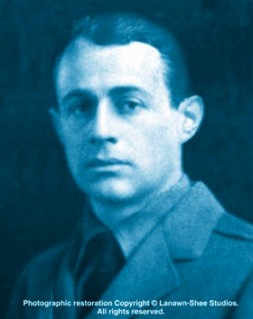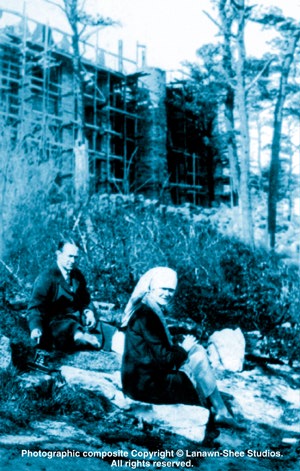

After a playboy existence which included several tours of Europe and connections
which read like a Who's Who of world society, Jack secretly married Gloucester
divorcée Irene Fenton Reynolds in 1925. He broke ground on their new home—a castle,
ostensibly as a wedding present for Irene—in 1926. It was located just down
the road from his parents' estate. His mother objected to his marrying a divorced
woman and his father objected to the cost of building a castle. Jack did as he pleased and when the castle was completed in 1929, he christened it Abbadia Mare— Latin for "Abbey-by-the-Sea"—because its interior was designed to resemble a restful medieval church. In 1930, Jack began the legal preparations which turned his castle into a non-profit museum to show off his medieval art collection and to achieve the same tax exempt status as his friend, Isabella Stewart Gardner, had done with her home—Fenway Court in Boston. The only section of his vast ocean-front property on which Jack ever paid taxes was the laboratory wing. |
In 1914, he remotely steered an unmanned yacht on a 120-mile voyage to Boston and
back. In 1921, he did the same for the Navy with an unmanned battleship in Chesapeake
Bay. Along the way, he developed radio-guided torpedoes, missiles, and other
top-secret weaponry. The inventions made him financially independent and earned him a seat on the Board of Directors of R.C.A. Newspapers, stunned to find him a young good-looking man, dubbed him "The Boy Inventor." The Franklin Institute initiated the more proper title—"Father of Radio Control"—when awarding Jack their Elliott Cresson Medal for life achievement in 1959.* John Hays Hammond, Jr., accumulated some 800 patents on more than 400 inventions.** Although in recent years, his museum would claim him to be "The World's Second Greatest Inventor" next to Edison, in Jack's own lifetime, he actually ranked sixth behind Edison. Still, no small feat and his intital inventions layed the groundwork for television remote controls, programmed car radios, and cell phones.*** __________________________________________________________________________________________________________ * The museum has always mistaken this title to be "Father of Remote Control." ** The museum has continually confused these numbers. The number of patents is always greater than the number of inventions because many different international patents can be held on the same invention. *** The museum also insists on referring to Jack as Dr. Hammond, when, in fact, his doctorate—no matter how well-deserved for his achievements—was an honorary degree orchestrated by Alexander Graham Bell. There is no evidence that Jack ever used the title in reference to himself or that he was ever addressed by such a title during his lifetime. __________________________________________________________________________________________________________ |
John Hays Hammond, Jr. and his Castle Museum |
John Hays Hammond, Jr.—known for most of his life as "Jack"—was born in San Francisco
on April 13, 1888. He was the second son and namesake of a world-famous mining
engineer, who was the friend, confidant, and almost running mate of William
Howard Taft. In 1893, Hammond, Sr., uprooted his family and trekked to the South African gold and diamond fields where he earned a reputed one-million dollars a year plus bonuses for his renowned expertise. |
While in South Africa, Hammond, Sr., worked with and became quite friendly with Cecil
Rhodes. It was through this association that Senior became involved in what
he thought to be a political demonstration against the despotic Boer government.
When the demonstration blundered, Senior was among those arrested, put on trial
for treason, and sentenced to death. He became so desperately ill from the
prison's poor sanitary conditions, that death might have seemed a blessing. Mark Twain, on a tour of Africa, visited the prison and helped call attention to the situation. Such press reports enabled Rhodes, by then back in England, to ransom Senior's release. Soon afterwards, the Hammonds relocated to convalesce in England. Jack was enrolled in an English prep school and, surrounded by castles, medieval history soon became one of his passions. He never outgrew it. Literally on the eve of the new century, in late December 1899, the Hammonds returned to the United States. Senior opened an office in Manhattan and purchased a home in upscale Lakewood, New Jersey, a fairly short train trip from New York City. Jack was then enrolled in prestigious Lawrenceville School near Princeton but he floundered in making an adjustment in his native country. To try and rectify things, Hammond, Sr., took his son along on a business appointment with Thomas Edison at the latter's West Orange, New Jersey, laboratory. Edison's queries about mining brought about no results, but he took a liking to Jack and gave him a personally guided tour of the lab and factory complex. Jack became fascinated with inventing and he proved to have an aptitude for it. His first invention controlled the lights in his Lawrenceville dormitory room by opening and closing the door. |
Copyright © 2003-2007 by John Dandola, Ltd. All rights reserved. |
John Hays Hammond, Jr. and his Castle Museum |

John Hays Hammond, Sr., posing with young Jack |

After Lawrenceville, Jack attended his father's alma mater, the Sheffield Scientific
School at Yale University. There he met Alexander Graham Bell, who was to become
his mentor. He also became familiar with the works of Tesla and Marconi.
Upon graduation in 1910, Jack intentionally took a job as a clerk in the United States Patent Office so that he could weigh which field would prove the most personally interesting and profitable for himself as an inventor. The answer was Radio. Jack left the Patent Office and, financed by his father, set up Hammond Radio Research Corporation on the grounds of the family's new seaside estate in Gloucester, Massachusetts. Here he began experimenting with radio remote control, managing to steer a variety of small unmanned boats around the harbor scaring vacationers and fishermen alike. |